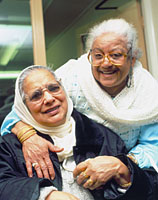|
|
Elderly Help Themselves and Others
By Curt Woodward, The Associated Press
March 8, 2005

Despite the challenges the elderly face in rural towns across America, there is no overlooking the value of neighbor helping neighbor.
Seniors are relying more on each other to keep living at home and they're getting help to tap into a wide range of programs for the day-to-day assistance they need to avoid moving to a nursing home.
In Robinson, that includes taking turns as a chauffeur to get friends to the senior center for meals or gathering them for a bus trip to Bismarck, about an hour away, for a doctor's appointment.
"We've had people that have had cancer and the whole town offers to drive them around," said Mary Lou Hanson, the center's manager. "It's a pretty close-knit community."
In Traverse County, Minn., a clutch of rural farm communities where more than a quarter of the 4,100 or so residents are older than 65, a "phone mate" program pairs the elderly or disabled to check on each other at a prescribed time each day. Volunteers also home deliver meals or drive older people to see a medical specialist.
Across the country, the need for such community safety nets is expected to climb significantly in coming years.
Census figures show the number of people 85 and older in the nation is expected to jump from about 4,200 in 2000 to nearly 21,000 in 2050.
North Dakota has the distinction of having the country's highest proportion of residents age 85 and older, and that population is growing. By 2020, state officials predict the number may jump to more than 24,000, nearly 4 percent of the population.
Robinson, a community of about 70, sits amid miles of farmland in central North Dakota.
Many residents, like 93-year-old widow Emilia Randall, wouldn't live anywhere else. She has lived in Robinson since 1968, when she moved off of the family farm.
"I call this God's country," she said. "The great, wide-open spaces - it's beautiful."
But to stay here, Randall and her friends need help, particularly if they no longer have a spouse.
More than 30,000 women in North Dakota are widows. In Kidder County, where Randall lives, about 42 percent of the people over 65 have outlived their husband or wife.
A low-income, eight-unit apartment building owned by 82-year-old Elsie Whitman is home to her and four other single ladies who look after each other, get together for regular card games and move in a pack from home to the senior center for meals.
Without that community of neighbors to rely on, "they'd have to be in nursing homes," Hanson said.
Even Randall drives other seniors to errands at the grocery store, the post office, around town or even to the mall or movie theater in Bismarck, although recent eye surgery left her temporarily grounded.
Networks of family and friends lend so much unpaid help to the elderly or disabled that losing their services "would break the Medicaid and Medicare system very quickly," said Cherry Schmidt, a regional administrator for the state's aging services program.
A recent study by the National Family Caregivers Association said more than 27 million people - usually family members - act as caregivers for others. The group said the market value of those unpaid services is about $257 billion each year.
In rural areas, where the population often is older, residents sometimes find themselves separated from relatives living in the city. That presents an extra challenge for caregivers.
"A great many people who are caregivers are people who might need the services of a caregiver themselves," said Andrew Zovko, a director at the caregivers association. "Certainly, an elderly person caring for another elderly person is a common situation."
And it's a situation that presents its own problems.
"Our volunteers are getting older and more frail," said Evie Rinke, an aging programs coordinator for Traverse County, Minn. "When it's ice and snow we wonder, 'Oh my, should we even send them out?"'
With elderly people and younger children making up a large portion of the county's population, "it doesn't leave a whole lot of us in that middle area to provide a lot of care for the elderly," Rinke said.
"It's like our state legislators are having a hard time understanding that we need to increase the funding to match the needs of the people," Randall said. "If there's more elderly and there's less money, what are you going to do?"
State officials say a relatively new federal program gives them some flexibility in offering help to those who are taking care of an elderly or disabled person at home. The National Family Caregiver Support Program allows states to tailor assistance to the particular needs of caregivers, said Judy Tschider, a regional coordinator.
In one case, a woman needed driving lessons because her husband, who had always handled the transportation, was in poor health and under her care.
"That can help her in taking care of him as well," Tschider said.
It also helps both of them stay in their community as long as possible. That's a familiar refrain for those who work with seniors, Randall said.
As she ate lunch with a group of ladies at the senior center in Tuttle, 78-year-old Rachel Wolff recalled that a doctor was puzzled by her decision to move to the small town when she decided to leave the family farm.
"He said, 'How come you moved to Tuttle? Why didn't you move to Bismarck?"' Wolff remembered.
Seventy-seven-year-old Anita Wagner answered for her: "You feel more at home here."
|
|



